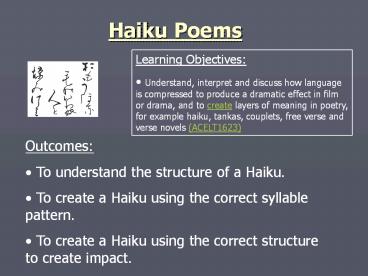Haiku%20Poems - PowerPoint PPT Presentation
Title:
Haiku%20Poems
Description:
... couplets, free verse and verse novels ... Summer: sun, hot, twilight, ladybirds, scorching sun, ice cream, beaches, sand, warmth, blue sky Autumn: ... – PowerPoint PPT presentation
Number of Views:152
Avg rating:3.0/5.0
Title: Haiku%20Poems
1
Haiku Poems
- Learning Objectives
- Understand, interpret and discuss how language
is compressed to produce a dramatic effect in
film or drama, and to create layers of meaning in
poetry, for example haiku, tankas, couplets, free
verse and verse novels (ACELT1623)
- Outcomes
- To understand the structure of a Haiku.
- To create a Haiku using the correct syllable
pattern. - To create a Haiku using the correct structure to
create impact.
2
Haiku
- A haiku is a form of Japanese poetry that has
only three short lines. - It has a fixed form.
- Usually the first line has five syllables, the
second has seven and the third has five again. - There are usually two ideas or images that
connect. - The poems are normally about nature.
Tea leaf in my cup Did you read your own
future, growing in China?
5 7 5
3
Haiku poems
As the wind does blow Across the trees, I
see the Buds blooming in May
Falling to the ground, I watch a leaf
settle down In a bed of brown.
I walk across sand And find myself blistering In
the hot, hot heat
Its coldand I wait For someone to shelter
me And take me from here.
4
Write your own haiku poem
- Read the words below in order to create your own
haiku poem on one of the seasons. - Summer sun, hot, twilight, ladybirds, scorching
sun, ice cream, beaches, sand, warmth, blue sky - Autumn falling leaves, red, gold, brown, rain,
starry nights, wind, crackling leaves - Winter snow, snowflakes, cold, dark, long
nights, icicles, gloomy, fires, ice skating - Spring flowers, green, grass, blossom, sunrise,
sky, spring rain, birth, nature, new life,
babies, growth.
5
- Using one of the images below, draft your own
Haiku remember the structure!
Water
Fire
Earth
Wind
6
Haiku writing
- Now write a haiku poem on the nature topic of
your choice. - As a class brainstorm a list of topics about
nature that you could write about. - It may help you to brainstorm some ideas on your
topic before trying to get the syllable structure
correct.
7
Haiku revision
- Where do Haiku poems originate from?
- What are Haiku poems usually about?
- What is the structure of a Haiku?
Japan
Nature animals, plants, weather, etc
First line 5 syllables Second line 7
syllables Third line 5 syllables
8
Peer Assess
Share your Haiku poems with a partner. Check the
syllable pattern. Comment on ? What was done
well? ? What could be improved?
- Outcomes
- To understand the structure of a Haiku.
- To create a Haiku using the correct syllable
pattern. - To create a Haiku using the correct structure to
create impact.
9
Couplets
- The easiest of the verse forms.
- Any topic you choose
- Two lines, with the last words of each rhyming
with each other. - Multiple couplets may be combined on one topic to
make one poem
10
Examples of couplets
- Grandmother sits in her old rocking chair.
- She rocks and she rocks all day there.
- Ideas with nowhere to hide An eureka moment
inside - Nature puts on little shows Every time it rains
or snows.
11
Your turn
- Use the topic of your choice to write a poem
consisting of at least 3 couplets (6 lines total) - It may help to think of rhyming word pairs and
then create the sentences about the topic around
the rhyme, rather than figuring out the rhyme at
the end

